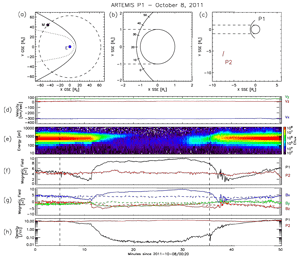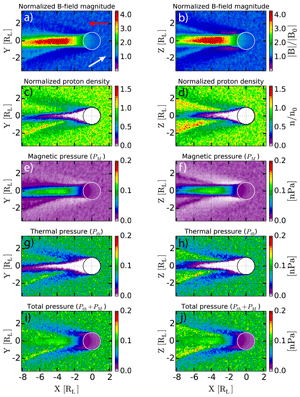2014 ARTEMIS SCIENCE NUGGETS
ARTEMIS observations of extreme diamagnetic fields in the lunar wake
by A. R. Poppe, Space Sciences Laboratory, U.C. Berkeley
Introduction
Airless bodies throughout the solar system, including the Moon, are exposed to the flowing magnetized plasma called the solar wind. Since the Moon has no global magnetic field or thick atmosphere, this plasma is absorbed on the lunar dayside, leaving a rarefied void on the nightside known as the lunar wake. Magnetic fields in the solar wind, however, pass through the Moon unchanged since the Moon is mostly a non-conductive body. Once these fields exit the Moon, they enter the lunar wake, which is in the process of being re-filled by plasma particles from the wake flanks. This inflow of plasma, which is attached to field lines, compresses the interplanetary magnetic field until pressure balance is approximately restored. The two ARTEMIS probes routinely observe these compressed magnetic fields, also called diamagnetic fields since they are related to diamagnetic currents on the wake flanks. Typically these compressions of the magnetic field are on the order of 110-120% of the ambient magnetic field strength. In this paper, we reported two cases where this compression was 230% and 250%, respectively, and attributed these extreme compressions to high plasma beta conditions.
| Figure 1. An observation of extreme diamagnetic fields in the lunar wake by the ARTEMIS P1 spacecraft on October 8, 2011. |
Observations
The ARTEMIS probes are in elliptical orbits around the Moon and the pass through the lunar wake at varying downstream distances approximately once per day. Figure 1(a-c) shows the lunar position relative to the Sun, and the positions of the P1 and P2 probes, respectively, on October 8, 2011 where extreme diamagnetic fields were observed. Figure 1(d-h) shows the observations for the wake probe during the crossing, including (d) the upstream solar wind velocity, (e) the ion differential energy flux, (f) the total upstream (red) and wake (black) magnetic fields, (g) the magnetic field components for each probe, and (h) the upstream and wake proton densities. The diamagnetic field in the wake, shown in panel 1(f) in black, is highly compressed inside the wake at approximately 2.5 times the ambient interplanetary magnetic field strength. Such large diamagnetic fields have never before been reported in the literature. Notably, during this observation, the high proton temperature in the terrestrial magnetosheath, approximately 40 eV, drove the plasma beta (the ratio of particle pressure to magnetic pressure) to higher than 10 – near the upper range of beta experienced at the Moon.
| Figure 2. Global hybrid model results of the lunar wake for conditions similar to that seen on October 8, 2011. |
Modeling
In order to help us understand the global structure of the wake during high plasma beta conditions, we have used a hybrid plasma model to simulate the wake during the October 8, 2011 fly-by. A hybrid model follows the motion of individual ions kinetically while using a fluid description for the electrons in addition to tracking electromagnetic fields. Figure 2 shows the hybrid model results for October 8, 2011, including the normalized magnetic fields, normalized proton density, and magnetic, thermal, and total (magnetic + thermal) pressure, respectively. The model shows that the magnetic field in the wake, panels (a-b), reaches a maximum of approximately 4 times the solar wind strength – even higher than observed by ARTEMIS, which cut through the wake at only approximately 1.2 RL downstream. This diamagnetic field enhancement in the wake is correlated with the dropout in proton density, panels (c-d). The modeled pressure helps to explain the increase in diamagnetic field strength. Outside the wake, the magnetic pressure, 2(e-f), is far lower than the particle pressure, 2(g-h); however, inside the wake, the thermal pressure drops to zero and thus, the magnetic pressure rapidly increases in order to help restore pressure balance. By approximately 3 RL downstream, the magnetic pressure has increased to the undisturbed thermal pressure, which marks the maximum diamagnetic field strength.
Conclusion
Both the ARTEMIS observations and the comparative hybrid modeling have shown that during time of high plasma beta (i.e., high thermal pressure to magnetic pressure ratio), diamagnetic fields in the lunar wake can drastically increase in magnitude. The high beta observations reported here now means that we can connect diamagnetic field increase in plasma wakes across several orders of magnitude in ambient beta, from < 0.03 reported at the Saturnian moons (i.e., Khurana et al., 2008) to >10 for that reported here for Earth’s Moon. This establishes beta as a key controlling parameter for the strength of diamagnetic fields throughout the solar system. Continued analysis of the ARTEMIS data may find greater examples of diamagnetic field strengths and also allow us to identify further trends in the behavior of the lunar wake on ambient plasma parameters.
Reference
Poppe, A. R., S. Fatemi, J. S. Halekas, M. Holmström, and G. T. Delory, ARTEMIS observations of extreme diamagnetic fields in the lunar wake, Geophys. Res. Lett., 41, 2014Biographical Note
Andrew Poppe is an Asst. Research Scientist in the Space Physics Research Group at the Space Sciences Laboratory / UC Berkeley. His research includes analysis of ARTEMIS data regarding solar wind and terrestrial magnetotail interactions with the Moon, as well as modeling and data comparison of interplanetary and planetary dust dynamics. See http://sprg.ssl.berkeley.edu/~poppe/ for more information.
 Please send comments/suggestions to
Emmanuel Masongsong / emasongsong@igpp.ucla.edu
Please send comments/suggestions to
Emmanuel Masongsong / emasongsong@igpp.ucla.edu

